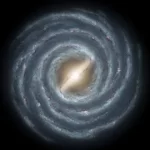Key Takeaways:
- Black holes, after devouring stars, display unexpected behavior—emitting radio waves in ‘burping’ episodes years later.
- Research indicates that up to 50% of star-eating black holes exhibit these delayed emissions of stellar remains.
- These phenomena stem from tidal disruption events (TDEs), where immense black hole gravity shreds stars into thin frisbee-like structures around them, called accretion disks.
- Observations challenge previous models, revealing unexpected behaviors such as multiple emission peaks and prolonged activity.
- The cause behind black holes ‘switching on’ and emitting radio waves years post-TDE remains a mystery, prompting further research.
In an astronomical spectacle defying conventional understanding, the cosmos reveals a stunning secret: black holes, notorious for consuming stars, have surprised scientists by rekindling these devoured entities. Twenty-four black holes, once star killers, suddenly emanated radio waves in peculiar ‘burping’ episodes, stirring perplexity among astronomers. Even more intriguing, half of the notorious star-gobbling black holes exhibit similar post-digestion activities.
This revelation stemmed from an extensive observation of black holes engaged in what scientists term “tidal disruption events” (TDEs). These cosmic encounters occur when stars venture too close to black holes, encountering incomprehensible tidal forces. The immense gravitational pull of these cosmic monsters subjects stars to spaghettification—stretching and compressing them until they disintegrate or get “unraveled” within hours. This cataclysmic event emits a dazzling burst of electromagnetic radiation visible across the cosmos.
The aftermath of a TDE witnesses the ejected stellar material flung away from the black hole while the remainder coalesces into an accretion disk—a thin, disk-shaped structure—that gradually funnels material back to the black hole. Initially unstable, this disk experiences turbulent collisions causing detectable outflows discernible through radio waves. Conventionally, scientists monitored these star-eating black holes for merely a few months following TDEs.
However, a paradigm shift occurred when astronomers extended their observation period to hundreds of days, revealing an astonishing revelation. In almost 50% of cases, black holes exhibited a delayed emission of stellar remnants years after the initial TDE.
Lead author of the study, Yvette Cendes, described this phenomenon akin to a ‘burp,’ signifying a delayed release of material, contrary to prior expectations. Astonishingly, this re-emission occurred between two to six years post-star-destruction for ten of the observed 24 black holes. Detailed in a study uploaded to the preprint database arXiv, these observations challenge existing models of black hole behavior.
Cendes highlighted the enigmatic nature of this resurgence, emphasizing that the source of this delayed emission does not originate within the black holes. Black holes, characterized by their event horizons—points where gravity becomes so potent that even light cannot escape—remain enigmatic entities. The emitted material detected via radio waves might either originate from the accretion disk or be stored closer to the black hole, underscoring the complexity of these cosmic devourers.
Surprisingly, computer models simulating TDEs typically terminate shortly after the star’s destruction, failing to capture the prolonged and unexpected behavior witnessed in this research. Notably, in two instances, black holes emitted radio waves that peaked, faded, and then surged again—an unprecedented occurrence challenging established scientific notions.
The team’s ongoing monitoring of these TDE-engaged black holes aims to unravel the mysteries behind their prolonged activity. As some continue to intensify in brightness, the quest to comprehend these cosmic phenomena propels astronomers into a realm of unprecedented discoveries, reshaping our understanding of the enigmatic relationship between black holes and the stars they consume.


